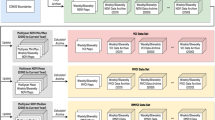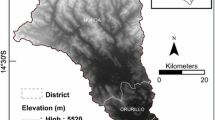Abstract
Technological barriers: Currently, most global datasets useful for environmental applications are archived in databases that can be accessed using the Internet. These include the GIMMS, NOAA-PAL, LTD, and FASIR datasets. There are also free online data service platforms for executing preprocessing operations (such as data smoothing, spatial and temporal subsetting, mosaiking, and re-projection) of MODIS time-series vegetation indices (such as NDVI and EVI). Currently, the Internet speed for many parts of the world remains too slow to enable effective access to these datasets or online processing.
Access provided by Autonomous University of Puebla. Download chapter PDF
Similar content being viewed by others
Keywords
These keywords were added by machine and not by the authors. This process is experimental and the keywords may be updated as the learning algorithm improves.
Technological barriers: Currently, most global datasets useful for environmental applications are archived in databases that can be accessed using the Internet. These include the GIMMS, NOAA-PAL, LTD, and FASIR datasets. There are also free online data service platforms for executing preprocessing operations (such as data smoothing, spatial and temporal subsetting, mosaicking, and re-projection) of MODIS time-series vegetation indices (such as NDVI and EVI) on request. Currently, the Internet speed for many regions of the developing world remains too slow to enable effective access to these datasets or online processing.
Technical capacity: NDVI is a relatively simple index to compute and use in a number of environmental assessments (Liang 2005). However, when it comes to land degradation assessment, the use of NDVI can be problematic, both in implementation and interpretation (Wessels et al. 2004). Therefore, the analysts need to be properly equipped with the intellectual and technical skills to contextualize the problems of land degradation for particular cases and the interaction of key variables (NDVI-, NPP-, or RUE-derived indices) in the process.
Institutional and policy barriers: Effective use of satellite remote sensing products and technologies for a range of environmental assessments at the national level requires an appropriate institutional and policy framework. At the national level, this means the creation and effective management of a geo-information infrastructure that enables decentralization of information management through integration of geographic information and remote sensing systems. The level of integration could vary, depending on the setup of a country’s administrative zones, the nature of land degradation being assessed, and the distribution of geo-information services in the country.
Barriers to effective knowledge management, decision support, and continuity: Given the complex array of environmental and socioeconomic processes involved in land degradation (Fig. 1.1), there is need for an effective system of knowledge and information management. Information has to flow between and across sectors (such as agriculture, nature conservation, and other kinds of land use) for a proper interpretation of the distribution and trends of NDVI signals. A meaningful assessment of historic trends in land degradation or changes in land productivity requires continuity in the system of data collection, analysis, presentation, and activities related to each dataset or process. In many countries, frequent changes of government constitute a major constraint on the implementation of some programs and projects—ongoing policies, programs, and projects are often abandoned—creating a knowledge and continuity gap that may prove difficult to fill when these programs and projects are relaunched.
Economic and financial barriers: While the most popular NDVI datasets from major archives are free, effective access, processing, and use require some investment. The level of investments required depends on the scale of operations envisaged. While many governments in poor countries may lack the financial resources to put in place the full range of investments required for optimal access and use of existing NDVI databases, the costs of key investments in the sector are diminishing. This is especially true of hardware, some software, and Internet service costs. Investment in a professional and technical cadre is a bigger, longer-term issue, but home-grown expertise is essential if there is to be national ownership of the issue and the results of any assessment.
References
Liang S (2005) Quantitative remote sensing of land surfaces, vol 30. Wiley, New York
Wessels KJ, Prince SD, Frost PE, van Zyl D (2004) Assessing the effects of human-induced land degradation in the former homelands of northern South Africa with a 1 km AVHRR NDVI time-series. Remote Sens Environ 91(1):47–67. doi:http://dx.doi.org/10.1016/j.rse.2004.02.005
Author information
Authors and Affiliations
Rights and permissions
Copyright information
© 2015 The Author(s)
About this chapter
Cite this chapter
Yengoh, G.T., Dent, D., Olsson, L., Tengberg, A.E., Tucker, C.J. (2015). Challenges to the Use of NDVI in Land Degradation Assessments. In: Use of the Normalized Difference Vegetation Index (NDVI) to Assess Land Degradation at Multiple Scales. SpringerBriefs in Environmental Science. Springer, Cham. https://doi.org/10.1007/978-3-319-24112-8_10
Download citation
DOI: https://doi.org/10.1007/978-3-319-24112-8_10
Published:
Publisher Name: Springer, Cham
Print ISBN: 978-3-319-24110-4
Online ISBN: 978-3-319-24112-8
eBook Packages: Earth and Environmental ScienceEarth and Environmental Science (R0)




